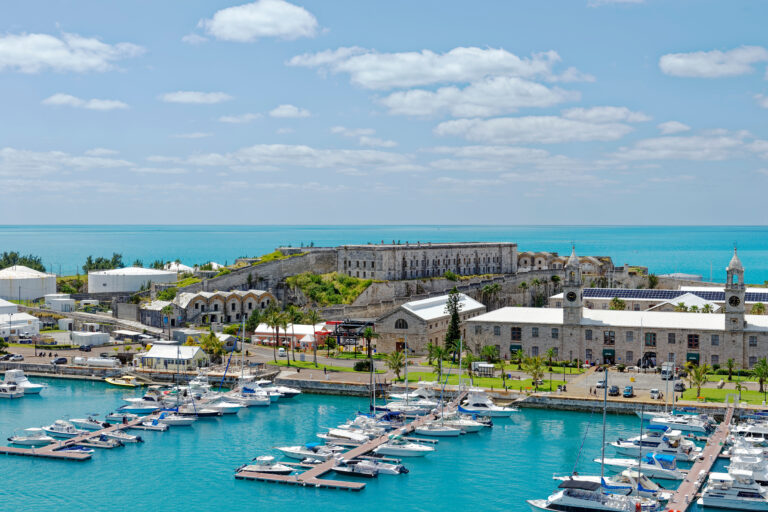Ireland Island has undergone a remarkable transformation, evolving from a remote penal outpost into a key naval stronghold of the British Empire. This transformation was significantly shaped by the resilience and labour of Irish indentured servants and convicts, who faced harsh conditions to leave a lasting imprint on both the physical and cultural landscape of the island.
Today, Ireland Island stands as a testament to their enduring legacy, reflecting the complex history of penal colonies and the enduring spirit of those who helped build it.
The connection between Ireland and Bermuda dates back to the mid-17th century, a period marked by English civil strife, and the brutal military campaigns of Oliver Cromwell. Dr. Clarence Maxwell, a historian specializing in the African diaspora and slavery, points out that Cromwell’s notorious conquest of Ireland was characterized by severe repression and mass displacements. According to Dr. Maxwell, this led to the forcible movement of thousands of Irish people, many of whom were expelled from Ireland and sent across the Atlantic as a form of retribution and to meet the labour demands of burgeoning British colonies.
Upon arrival in Bermuda, these individuals found themselves stripped of freedom and bound to terms of indentured servitude; typically lasting seven years. During this period, they were compelled to work in the island’s emerging tobacco industry, and later, as the economic focus shifted, in the expanding maritime enterprises – centred around the Royal Naval Dockyards on Ireland Island.
Dr. Maxwell’s research highlights the pivotal role these Irish indentured servants played in shaping Bermuda’s early economic landscape, setting the stage for a deeper exploration of their contributions and legacies.
The role of the Irish in the transformation of Bermuda’s naval capabilities is profound. Beginning in 1824, Bermuda saw the arrival of prison ships carrying hundreds of individuals, including Irish convicts and indentured servants, who were to labour in the dockyards under gruelling conditions. This practice, part of a British government experiment to utilize convict labour in remote colonies, continued for nearly 40 years.
The dockyard, which was essential for the maintenance and repair of British naval vessels traveling to North America and the Caribbean, was desperately in need of modernization. Instead of employing local labour, which sparked significant local resistance, the British government opted to use convicts as a cheap and easily mobilizable workforce. This decision was not without controversy, as local tradespeople, shipbuilders, and whalers expressed their disapproval through newspaper complaints, fearing the moral and social implications of integrating convicts into their community.
While both Irish indentured servants and African slaves in Bermuda endured brutal conditions, their legal and social statuses differed significantly. According to Dr Maxwell, Irish indentured servants, bound to their employers for a fixed term – usually seven years – faced a decrease in their perceived value as their period of servitude neared its end, reducing their leverage and treatment in the labour market. In contrast, slaves were considered property for life, with no rights to freedom or autonomy. This distinction impacted the dynamics of labour and social hierarchy on the island.
Over time, as the economic viability of permanent slave labour became apparent, the reliance on indentured servitude diminished, giving way to an increased dependence on slavery, marking a grim evolution in Bermuda’s labour practices.
Dr Maxwell notes that the cultural influence of the Irish on Bermuda is enduring, particularly visible in places like St. David’s, where place names and family surnames echo the historical presence of the Irish. These cultural markers stand as a testament to the profound legacy of the Irish in Bermuda, integrating their historical and cultural contributions into the fabric of the island.
The story of John Mitchel, an influential Irish nationalist and journalist detained on the hulks in Bermuda, further illustrates the island’s role in the broader struggles of Irish nationalists under British governance. His writings provide insight into the harsh conditions faced by political exiles, underscoring the broader narrative of forced labour and resistance.
Reflecting on the impact of Irish indentured servants in Bermuda helps to offer a deeper understanding of how the island transformed into a vital component of the British Empire. The Irish legacy is a critical component of Bermuda’s cultural heritage, reminding us of the complex layers of history that shape our present.
The naming of Ireland Island serves as a historical nod to the significant Irish labour that contributed to its development, and the island’s strategic importance as a naval base, linking Ireland and Bermuda in a shared legacy of colonial history and transformation. As we reflect on this history, the stories of those who lived, worked, and died under oppressive conditions in Bermuda serve as a sobering reminder of the human cost of empire and colonization. This broader perspective not only deepens our appreciation of Ireland Island’s historical significance, but also invites us to consider the lasting effects of these historical practices on present-day societal and cultural norms.
Bermuda has transformed from a remote prison island to a major naval centre, to a popular tourist destination. This remarkable evolution showcases not just the dynamic power of history to reshape landscapes, but also the extraordinary resilience of individuals who faced, and overcame, daunting challenges.
The story of Ireland Island, rich with tales of endurance and adaptation, is not just a vibrant chapter in our past; it continues to inspire and influence Bermuda today. As we walk the beaches and streets that were once sites of labour and struggle, we carry forward the legacy of those who built this place, reminding us that our history is not just to be remembered, but to be learned from.

